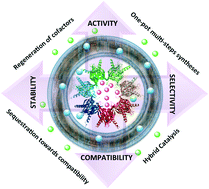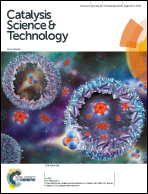From sequential chemoenzymatic synthesis to integrated hybrid catalysis: taking the best of both worlds to open up the scope of possibilities for a sustainable future
Abstract
Enzymatically catalyzed reactions are highly efficient but higher scale extrapolation is limited to a certain class of stable and easily recyclable enzymes. Homogeneously and/or heterogeneously catalyzed reactions are often limited by the multiphasic nature of catalytic systems and/or variations in the distribution of active sites. For these reasons, the development of highly selective and efficient hybrid catalysts is especially needed, and it is now well admitted that disruptive innovation is highly desirable in process engineering, (bio)catalyst design and materials science. Optimal integration of all types of catalysis is the key for efficient global implementation of sustainable processes. This review gives an overview of all the pathways that integrate chemical and biological catalysis, beginning with combined chemoenzymatic processes in cascade to progressively open the field of hybrid catalysis in a one-pot concomitant execution. We have emphasized the factors that have to be considered to understand the catalytic synergy between these systems. A better understanding of hybrid catalytic systems is an essential tool not only in the choice of the best route of their implementation but also in the synthesis of a wide range of fine chemicals in many fields, with a particular emphasis on their production from renewables.



 Please wait while we load your content...
Please wait while we load your content...